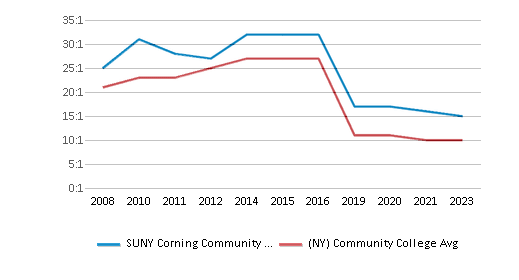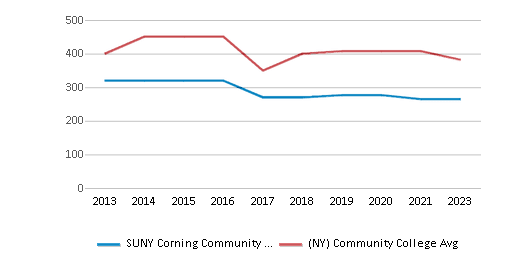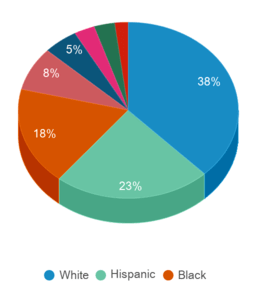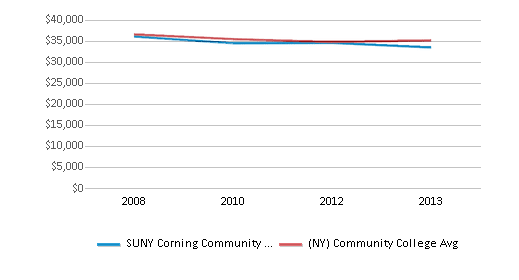- Corning Community College offers an extensive yet affordable range of educational, cultural, and social opportunities to a diverse population of full-time and part-time learners. We focus on student achievement by stressing quality teaching and personal attention. Our emphasis on high standards of quality and technological advancement provides a flexible learning environment in which students are prepared for a life of service to their professions and their communities in a globally interdependent society. We promote intellectual and personal growth, meet the educational needs of the community through transfer, career, certificate, and training programs, and enhance economic development.
School Highlights
SUNY Corning Community College serves 4,505 students (31% of students are full-time).
The college's student:teacher ratio of 18:1 is higher than the state community college average of 13:1.
Minority enrollment is 50% of the student body (majority Black and Hispanic), which is less than the state average of 62%.
Quick Stats (2025)
- Enrollment: 4,505 students
- In-state tuition: $4,700
- Out-state tuition: $8,850
- Student:teacher ratio: 18:1
- Minority enrollment: 50%
- Source: Integrated Postsecondary Education Data System (IPEDS)
School Overview
The teacher population of 256 teachers has stayed relatively flat over five years.
SUNY Corning Community College
(NY) Community College Avg.
Carnegie Classification
Associate's Colleges: High Transfer-High Nontraditional
Baccalaureate/Associate's Colleges: Mixed Baccalaureate/Associate's
Institution Level
At least 2 but less than 4 years
At least 2 but less than 4 years
Institution Control
Public
Private not-for-profit
Total Faculty
256 staff
158 staff

School Calendar
Student Body
The student population of SUNY Corning Community College has grown by 6% over five years.
The student:teacher ratio of 18:1 has increased from 16:1 over five years.
The SUNY Corning Community College diversity score of 0.75 is less than the state average of 0.76. The school's diversity has grown by 37% over five years.
Total Enrollment
4,505 students
746 students

Student : Teacher Ratio
18:1
13:1

# Full-Time Students
1,397 students
519 students

# Part-Time Students
3,108 students
514 students



# Enrollment Undergraduate
450 students
357 students
# Full-Time Undergraduate Students
1,397 students
502 students

# Full-Time Graduate Students
n/a
44 students
# Part-Time Undergraduate Students
3,108 students
528 students
# Part-Time Graduate Students
n/a
41 students
Total Dormitory Capacity
265 students
382 students

% American Indian/Alaskan
n/a
n/a

% Asian
2%
8%

% Hispanic
2%
23%

% Black
3%
18%

% White
50%
38%

% Hawaiian
n/a
2%

% Two or more races
n/a
3%

% Non Resident races
n/a
3%
% Unknown races
42%
5%


Diversity Score
0.75
0.76

College Completion Rate (Students who graduate in less than 4 years)
0.4018%
0.3518%

College Completion Rate (Students who graduate in 4 years or more than 4 years)
n/a
0.3957%
Average Graduate Earnings (10 Years)
$33,500
$35,200

Tuition and Acceptance Rate
The public in-state tuition of $4,700 is less than the state average of $5,720. The in-state tuition has declined by 19% over four years.
The public out-state tuition of $8,850 is less than the state average of $10,320. The out-state tuition has stayed relatively flat over four years.
In-State Tuition Fees
$4,700
$5,720

Out-State Tuition Fees
$8,850
$10,320

% Students Receiving Some Financial Aid
83%
88%

Median Debt for Graduates
$11,950
$13,841

Median Debt for Dropouts
$6,376
$5,500

Acceptance Rate
n/a
74%
SAT Reading
n/a
475
SAT Math
n/a
505
SAT Writing
n/a
485
ACT Composite
n/a
20
ACT English
n/a
18
ACT Math
n/a
20
Source: 2024 (or latest year available) Integrated Postsecondary Education Data System (IPEDS)
School Notes
- Founded in 1956 by the Corning-Painted Post School District, CCC began modestly in a scattering of old buildings in the city of Corning. Today, we encompass a 550-acre main campus on Spencer Hill with a complex of eight buildings plus an observatory and planetarium. We've also expanded our vision to provide services at a variety of off-campus sites throughout Steuben, Chemung and Schuyler counties. Students from age 16 to 70 attend CCC and take courses in 48 different degree and certificate programs leading to careers or transfer to further education. Many doctors, engineers, lawyers, nurses, business people, teachers, technologists and even an astronaut have begun at CCC. Currently, approximately 3,300 full-time equivalent (FTE) students are enrolled, representing 5,000-6,000 students taking our fully accredited credit offerings. Whether your goal is to transfer to a four-year college, enhance your current job skills, or begin a career Corning Community College is the smart choice. CCC provides an excellent educational foundation at an affordable price, and students may attend on either a full-time or part-time basis, depending on individual need. Our unique programs, comfortable learning environment, and dedicated faculty and student support staff create a campus community that enhances the learning experience for each student.
Frequently Asked Questions
How much does SUNY Corning Community College cost?
SUNY Corning Community College's tuition is approximately $4,700 for In-State students and $8,850 for Out-State students.
Recent Articles

Obtaining Your Bachelor's Degree at a Community College
Explore the evolving landscape of community colleges offering bachelor's degrees, addressing affordability, accessibility, and workforce needs.

A to Z of Community College Certificates and Courses
From business and healthcare to technology and skilled trades, the article showcases the breadth of options available to students seeking to enhance their knowledge, develop new skills, or pursue career advancement.

What is a Community College?
This comprehensive guide explains what a community college is, its history, and its role in higher education. It covers the types of programs offered, differences from four-year colleges, benefits of attending, and important considerations for prospective students, providing valuable insights for those exploring educational options.











